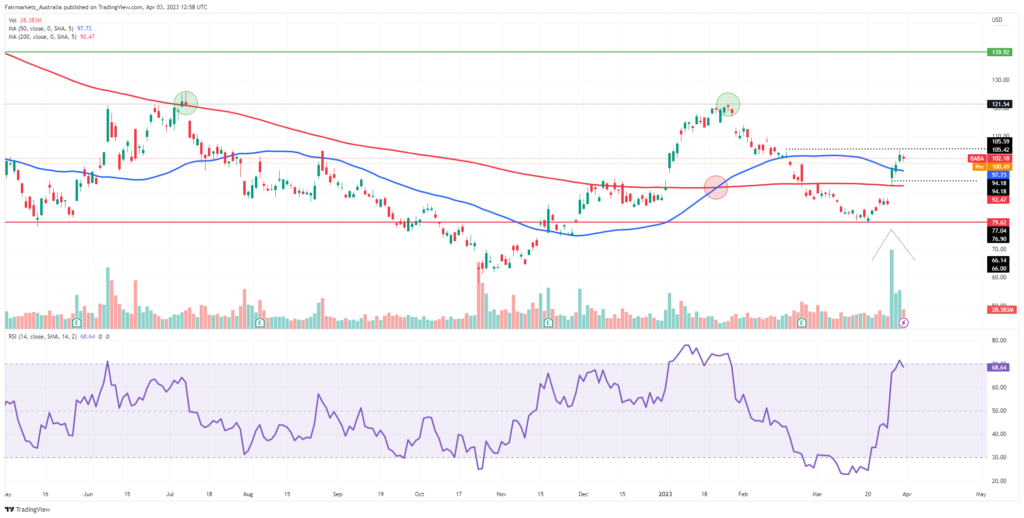China’s technology conglomerate Alibaba (NYSE: BABA) surged over 20% in three trading days as investors united their opinion over the company’s announced split into six separate entities. While the move was met with enthusiasm from the market, investors will keep one eye on the remaining risks in the company’s operating environment to determine whether the proposed split is the answer to the company’s recent woes.
From the company’s October 2020 highs, Alibaba has lost almost 65% of its value, as Chinese demand contracted heavily from the tight restrictions implemented during the Covid-19 lockdowns. The government has also scrutinized big technology companies in China, with regulatory constraints posing a major headwind to the core growth of Alibaba’s business. These changes in the global environment have prompted the restructuring changes as management looks to improve flexibility and efficiency across its business segments.
Technical
Technical indicators signal a bullish stronghold on the 1D chart. With a formation of a golden cross, while the shares are trading above the 50-day moving average on an RSI that signals intense buying pressure, bullish momentum may persist.
However, the market could correct its recent surge, which could force the share price to retest the gap resistance at $94.18. If support fails, the market could correct the buying influx and shift the share price back down to look for lower support at $79.62.
However, if support does hold, the share price could converge toward its estimated fair value of $139.92, which was derived on a discounted cash flow basis. Resistance could be met at $105.42 and $121.54, a psychological resistance level that may require some further fundamental backing to force a breakout. A long-term opportunity could open up a potential 37% upside from current levels if the company can execute its latest restructuring plan.

Fundamental
The core driver behind Alibaba’s share price flounder in recent years has revolved around the stunting growth of their Chinese e-commerce business. This market may have reached a maturing phase, limiting further growth momentum over the longer term. Although the revenue from this segment has expanded by 18% in fiscal 2022, the first nine months of their latest financial year have only seen a 1% year-on-year growth. This segment accounts for 69% of the company’s top line, with its profitability subsidizing the expansion of other segments, such as its digital media and entertainment segment. Furthermore, antitrust regulators in China have squeezed Alibaba’s business and growth capacity by implementing fines and restrictions on their deals with merchants. Due to these risks, the announced split was well received, as it was seen as an opportunity to alleviate the main risks facing the technology giant.
The restructuring plan would be the biggest in the company’s 24-year history. The company will spin off into six business groups: Cainiao Network Technology Logistics, Cloud Intelligence, Local Services, Global Digital Business, Digital Media & Entertainment and Taobao Tmall Commerce. All of the above groups will be allowed to raise external capital and pursue individual initial public offerings (IPOs), except for the Taobao Tmall Commerce business unit, their Chinese e-Commerce segment that will remain wholly owned by Alibaba. As these companies will all be run by their own CEO and board of directors, the decision will provide these management teams with more strategic autonomy in executing specific plans to unlock value in their respective segments. The CEO of Alibaba, Daniel Zhang, explained how the company’s relationship with its units would change to be more of an asset and capital operator rather than a business operator. So what does this mean for investors?
The split will allow each entity to scale its businesses and attract external investors to raise cash through initial public offerings. This will enable management to enhance their decision-making processes to react and respond faster to market changes in their respective areas while promoting innovation through an agile business model. The individual investor will be able to gain more extensive insight into the individual performance of the respective sectors. At the same time, the overall business could experience relief from Chinese regulators, with the separate entities more closely meeting the compliance requirements of these antitrust regulators. However, that does not mean that the company-specific risks have disappeared.
The demand for IPOs has been considerably low in the current uncertain macroeconomic environment. Alibaba may need a catalyst from extensive external investments to grow their cash flow to expand their now smaller entities and compete with some industry giants. Geopolitical tensions between the US and China pose a further risk to the company, in addition to the regulatory and macroeconomic risks involved.
Summary
The market well received Alibaba’s announcement to split into separate entities. The decision has triggered a potential catalyst to unlock incremental value into certain unprofitable segments of their business while pushing to be more compliant with the Chinese antitrust regulators’ demands. If the company manages to navigate the uncertainty with a successful campaign of generating external cash flows into their separate entities, they could unlock a potential 37% upside from current price levels toward $139.92.
Sources: Koyfin, Tradingview, Investor’s Business Daily, Yahoo Finance, Alibaba Group Holding Limited


